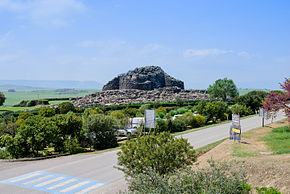Su Nuraxi (Barumini)

Su Nuraxi in Barumini
|
|
| Location | Barumini, Sardinia, Italy |
|---|---|
| Coordinates | 39°42′21″N 8°59′26″E / 39.70583°N 8.99056°ECoordinates: 39°42′21″N 8°59′26″E / 39.70583°N 8.99056°E |
| Type | Settlement |
| History | |
| Founded | 17th century BCE |
| Abandoned | 6th century BCE |
| Periods | Bronze Age |
| Cultures | Nuragic civilization |
| Site notes | |
| Excavation dates | 1950-1957 |
| Archaeologists | Giovanni Lilliu |
| Official name | Su Nuraxi di Barumini |
| Type | Cultural |
| Criteria | i, iii, iv |
| Designated | 1997 (21st session) |
| Reference no. | 833 |
| Region | Europe and North America |
Su Nuraxi is a nuragic archaeological site in Barumini, Sardinia, Italy. It was included in the UNESCO list of World Heritage Sites in 1997 as Su Nuraxi di Barumini.
Su Nuraxi simply means "The Nuraghe" in Campidanese, the southern variant of the Sardinian language.
Su Nuraxi is a settlement consisting of a seventeenth century BCE Nuraghe, a bastion of four corner towers plus a central one, and a village inhabited from the thirteenth to the sixth century BCE, developed around the Nuraghe. They are considered by scholars the most impressive expression of the Nuragic civilization and were included in the UNESCO list of World Heritage Sites in 1997.
The oldest part of the Nuraghe consists of a central tower with three superposed chambers (18.6m high). It was built in blocks of basalt between the seventeenth and thirteenth centuries BCE. Later, during the Late Bronze Age, four towers joined by a curtain wall with an upper balcony (no longer extant) were built around the central tower, all communicating with an inner courtyard served by a well. During the Iron Age, the complex was surrounded by a curtain wall with seven lobes (heptalobate).
The real function of the nuraghe is still debated. The discoverer of Su Nuraxi, the archaeologist Giovanni Lilliu, confirmed the traditional interpretation of fortress-site. Other archaeologists believe that the oldest part of the dolmen was destined for a religious purpose, refuge, civil or even parliament or registered the village chief, while the towers were added perhaps intended for military purposes and stock.
A village, intended to accommodate the surrounding population, was built around the Nuraghe in the Late Bronze Age. The village consisted of about fifty huts, and was built on a circular plan with large boulders covered with dry stone walls and conical roofs made of wood and branches. Though the huts were structured in a single unit in more remote periods, there was a later, more prevalent tendency to subdivide housing into individual units. Of the huts found, the most significant appear to have been reserved for meetings of the local leaders. These huts were larger and more complex in structure, and the hut reserved for the inhabitants' meetings contained symbols of the deities worshiped by locals. Other rooms have been identified as workshops, kitchens, and agricultural processing centres.
...
Wikipedia

